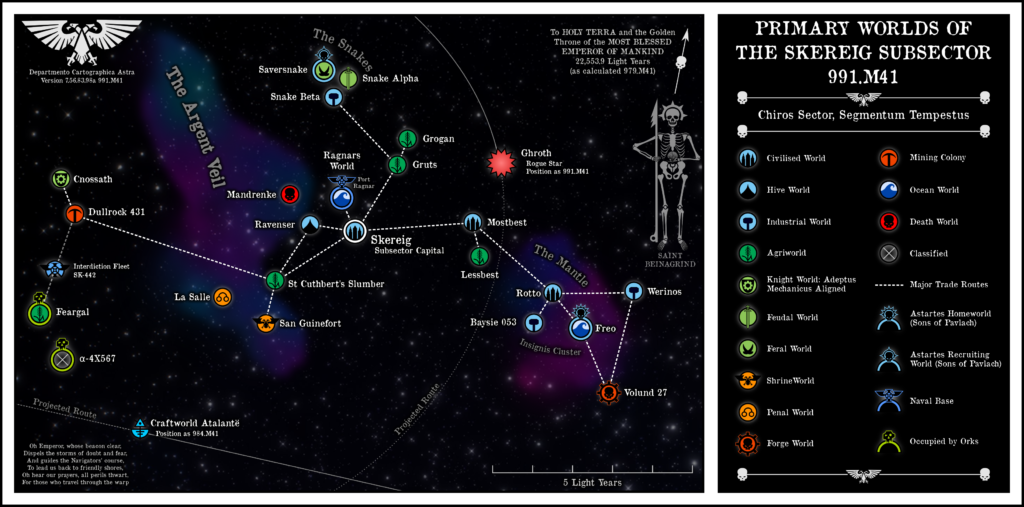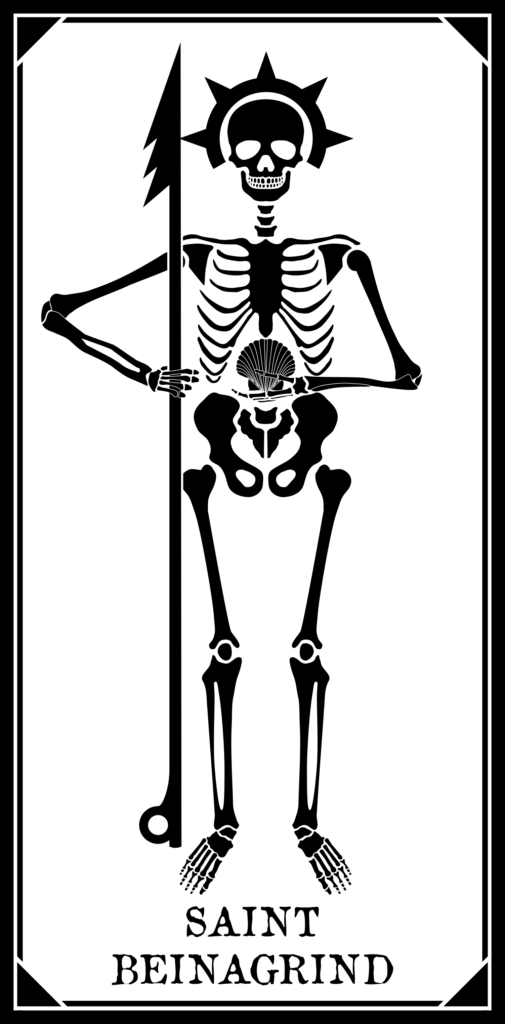This post is part of the Skereig Subsector project

Overview
The Skereig Subsector is located in the Chiros Sector on the western side of the Segmentum Tempestus, close to the border of the Segmentum Pacificus, around 22,500 light years from Holy Terra. It has remained loyal to the Emperor for several thousand years, despite occasional isolation by warp storms and Xenos incursions.
The subsector extends for 15 light years around the Skereig system, although the furthest inhabited world is just over 8 light years from the capital. There are numerous uninhabited worlds further out, some of which are scheduled for colonisation over the next few centuries.
As of 991.M41 the subsector is dealing with the aftermath of an invasion by the Orks of Waaagh! Krumpfist, who attacked from the galactic south-west in 923.M41. Invasions of several systems – including Cnossath and St Cuthbert’s Slumber were repelled, but two systems remain under Ork control. The Subsystem Governor has been appealing to Imperial authorities for support in retaking these systems for over 7 decades, particularly the agriworld of Feargal, the loss of which has caused food shortages across the subsector.
Saints
The two most popular Saints in the Skereig Subsector are Saint Guinefort and Saint Beinagrind.
Saint Guinefort was the pet canid of High Ecclesiarch Zosimus CXXXVII of the Orphean Conclave. During an official visit to the Basilica of Saint Hermon on Skereig Prime in 885.M39 the Ecclesiarch was informed that he could not bring the animal inside. He reacted to this by immediately canonising the creature. Unable to bar entry to a confirmed Imperial Saint the door wardens reluctantly acquiesced and the canid accompanied the Ecclesiarch to all religious services for the duration of his stay in the subsector.
The general unpopularity of the Ecclesiarch – who was notable for his more worldly appetites – appears to have encouraged adulation of his saintly canid instead, although it is certainly possible that such worship was initially tongue in cheek, only transitioning to a genuine cult in later centuries.
Saint Guinefort is invoked as a protector of children and a defender of the Emperor’s realm against Xenos infiltration. He is typically depicted as a noble hunting hound with yellow or golden fur. This is despite accounts from the period describing the animal as resembling a stumpy-legged, overstuffed sausage with thinning fur and a jowly, scowling face.
Saint Beinagrind, also know as the Holy Skeleton or Saint Bones is said to have been martyred on Ragnar’s World some time in M36. During a time of religious schism he remained true to the Imperial Creed and was executed by having his flesh scraped from his bones with sharpened scallop shells. Afterwards his bare skeleton arose and took holy vengeance by killing his persecutors. Attempts to correlate the legend with historical records have failed, nonetheless the Holy Skeleton remains popular on all worlds in the subsector, invoked against heresy and loss of faith.
Saint Beinagrind is typically depicted as a human skeleton bearing a scallop shell in its left hand and a fishing harpoon in its right – this being the tool he is said to have used to slay his murderers.
Notable Worlds
Cnossath: Cnossath is a Knight World allied to the Adeptus Mechanicus Forgeworld of Volund 27. It is home to three Knight Houses, Ventris, Cashel and Krater and with the assistance of the Valhallan 294th “Toecutters” Astra Militarum Regiment repelled the Orks of Waaagh! Krumpfist in 925.M41. More on Cnossath…
Dullrock 431: Apparently named by an extremely bored Explorator this lifeless body was later found to be rich in numerous rare minerals, with mining colonies established in the early 300s.M41. The highly corrosive atmosphere requires all colonies to be heavily shielded, with the majority of facilities placed deep underground adjacent to the ore deposits. Some Ork landings were reported in the 920s.M41, but the hostile conditions appear to have made short work of the would-be invaders.
Feargal: A highly fertile agriworld, Feargal supplied much of the subsector’s grain before being occupied by the Orks of Waaagh! Krumpfist in 923.M41. An expedition to reclaim the world has been waiting for Astra Militarum support for close on 75 years.
Gruts: An agriworld famous for a variety of wild truffle traditionally prepared by frying in butter. Several forested areas of the planet have been left undeveloped solely for the production of these rare delicacies.
La Salle: An arid, sun-blasted, desert world, La Salle is rich in rare mineral salts which are extracted by convicted criminals from across the subsector. Being condemned to the salt mines of La Salle is as good as a death sentence for all but the strongest convicts, with very few surviving the 20 years of servitude required for a preliminary parole hearing.
Mandrenke: The ocean world of Mandrenke teems with life, almost all of it inimical to humanity.
Ragnar’s World: An ocean world chiefly notable for the subsector’s main Naval facility, the orbital shipyards of Port Ragnar. It is also the reputed site of the martyrdom of Saint Beinagrind and many pilgrims make the journey to worship at the Grand Basilica on the island of Saint Skeleton, or the smaller, rival, Shrine of Bones on Beinagrind’s Strand.
Ravenser: The subsector’s only significant hive world, Ravenser has six major hive cities and around four-dozen smaller dependent hive conglomerations with a total estimated population of around 120 billion. The majority of the subsector’s manufactured goods are produced on Ravenser with raw materials sourced from the system’s three massive asteroid belts.
Keeping the population of Ravenser fed has always presented a challenge, but has been particularly problematic since the occupation of agriworld Feargal by the Orks in 923.M41. Food related riots and uprisings have become a permanent feature of the planet with three entire regiments of Skereig Varyags seconded to the planetary Arbites to enforce the peace.
San Guinefort: Named after the Saintly Hound, San Guinefort is home to the Battle Sisters of the Order of the Argent Veil – a minor order believed to have split off from the Order of the Sacred Rose in the early M40s.
St Cuthbert’s Slumber: An unremarkable agriworld, St Cuthbert’s Slumber was invaded by the Orks of Waaagh! Krumpfist in 924.M41. The attackers were successfully confined to the northern continent, but the Xenos scourge was not completely eliminated until 932.M41. Advice on proper cleansing of contaminated areas from Valhallan units in the relief force has kept feral Ork outbreaks to a minimum.
Werinos: Werinos is a mostly oceanic world with highly acidic oceans. The major native form of life are gigantic bacterial colonies established around deep geothermal vents and extending into the planetary crust. These colonies produce massive amounts of volatile gas which diffuses into the oceanic water column, from which it is extracted by thousands of floating platforms and piped to refineries on the single, middle sized continent on the planet’s equator for conversion into promethium. Promethium exports from Werinos provide upwards of 80% of the subsector’s fuel requirements.
Much technology on Werinos and on the nearby Forgeworld of Volund 27 has been adapted to use the gas in its raw form, with both planets’ manufactoria greatly skilled in the production of highly efficient gas turbines. The experimental Werinos Pattern Gatling Cannon uses two such miniature turbines for power, providing the same rate of fire as a standard Punisher Cannon with a simpler mechanism and fewer moving parts. Deployment of Werinos Pattern cannons on the battlefield is currently limited by the difficulty of keeping them supplied with gas – they are common on both Werinos and Volund 27, but are rare elsewhere.


